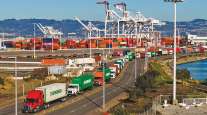Staff Reporter
US Ports Report Continued Volume Gains in First Quarter

[Stay on top of transportation news: Get TTNews in your inbox.]
U.S. ports closed out the first quarter in March with continued year-over-year increases in container volumes.
The Port of Los Angeles reported that it processed 743,417 20-foot equivalent units, a 19.3% improvement from 623,234 in 2023. This marked the eighth consecutive month of year-over-year growth at the port. Container volumes for the first three months of the year increased 30% to 2,380,503.
“Moving into April and the second quarter, I expect robust cargo flow to continue here,” Port of Los Angeles Executive Director Gene Seroka said during a media briefing April 17. “A strong job market and continued consumer spending, along with our ability to handle additional volume, will help drive cargo to Los Angeles in the coming months.”
The Port of Long Beach reported that container volumes for the month increased 8.3% year-over-year to 654,082 containers from 603,878, marking the seventh straight month of year-over-year cargo growth. Container volumes for the first three months of the year rose 16.4% to 2,002,820.
Port of Los Angeles Executive Director Gene Seroka describes how he expects the current robust cargo flow at our nation’s busiest port to continue in April and the second quarter. The key? Consumer spending along with a strong job market. pic.twitter.com/SplBFoR97e — Port of Los Angeles (@PortofLA) April 25, 2024
“Consumer demand remains strong and continues to drive cargo through this vital gateway for transpacific trade,” Port of Long Beach CEO Mario Cordero said. “We will continue to build the infrastructure that will allow us to grow our trade strategically and sustainably.”
The Port of Oakland reported that container volume increased 19.1% year-over-year to 202,816 from 170,268. This marked the fifth consecutive month of full import volumes increasing from the prior year. Port leaders credited rising incomes and rising net worth among consumers in major Northern California markets for supporting import growth. This also is the highest monthly total for full outbound cargo since April 2021.
“I am encouraged that the positive cargo trends we are seeing in 2024 continue,” Port of Oakland Maritime Director Bryan Brandes said. “A strong economy and the need for retailers to replenish stock in their warehouses are driving import cargo activity today.”
March container volume at the Oakland Seaport grew; full imports and exports close first quarter strong #containervolume #ports#portofoakland https://t.co/4orlpMwaHg — Port of Oakland (@PortofOakland) April 24, 2024
The Northwest Seaport Alliance noted that combined volumes between the ports of Seattle and Tacoma, Wash., increased 8.5% to 261,495 from 240,979 containers. The alliance noted that full international exports have reached a seven-month growth streak. Container volumes for the first three months of the year inched up 2.9% to 699,382.
Port Houston reported that volumes increased 20.1% year-over-year to 360,991 containers from 300,589. Port leaders noted that consumer spending on items such as furniture and appliances contributed to loaded import volumes increasing 23% from the year-ago period. Container volumes for the first three months of the year increased 15% to 1,069,917.
Port Houston is a steward of progress through the Houston Ship Channel. We continue our efforts to maintain and improve the channel by expediting our work through Project 11. To learn more about this vital waterway, visit: https://t.co/K392bo6vFS#MaritimeIndustry #Infastructure pic.twitter.com/8hv4gwmd2i — Port Houston (@Port_Houston) April 26, 2024
“The improvements we continue to make at our facilities, combined with a committed workforce, have allowed us to efficiently handle the double-digit growth in both imports and exports during the first quarter,” Port Houston Executive Director Roger Guenther said. “Our customers can count on us to continue to invest in the infrastructure and people we need to move their cargo quickly through our terminals as demand increases.”
Georgia Ports Authority said container volumes increased 18.5% year-over-year to 436,000 from 367,880. This was driven in part by intermodal rail cargo going through the Port of Savannah increasing 22% to 44,902 containers. The port achieved growth of 11% in total container trade during the first three months of the year.
@GaPorts saw an 18.5% increase in trade during March, compared to the same month last year. Watch GPA President & CEO Griff Lynch discuss the reason for the increase of both container volume and intermodal freight. https://t.co/uzoSSiAH8C pic.twitter.com/HCKgRzIwhW — Georgia Ports (@GaPorts) April 10, 2024
“With double-digit growth in the first quarter, we’re excited about where we’re going and thankful for the continued trust our customers place in Georgia Ports,” GPA President Griff Lynch said. “No other port in the country can match Savannah’s efficient operations, thanks to our GPA employees and our partners at the International Longshoremen’s Association and Gateway Terminals.”
South Carolina Ports Authority reported that volumes increased 12.1% to 216,410 containers from 193,085 in 2023, signifying the most significant increase this year. Port leaders noted a rise in loaded imports, and strong intermodal cargo movements drove year-over-year volume growth.
“The U.S. East Coast is in high demand for cargo routings, and our strategic location in the booming Southeast positions us well for long-term growth,” SC Ports President Barbara Melvin said. “South Carolina Ports offers highly productive, capable and reliable port service to our customers.”
A 17% increase in loaded imports and strong intermodal cargo movements drove year-over-year container volume growth at South Carolina Ports, marking the most significant uptick this year.https://t.co/AUvqghG72r — South Carolina Ports (@SCPorts) April 17, 2024
Port Authority of New York and New Jersey usually runs one month behind the other ports in releasing its numbers. In February, the facility experienced a 22.1% increase year-over-year in volume to 701,648 containers from 574,452.
The Port of Baltimore and Port of Virginia did not have volume numbers available at press time. Both ports have experienced disruptions in their normal operations in the aftermath of the Francis Scott Key Bridge collapse in Baltimore on March 26.
Want more news? Listen to today's daily briefing below or go here for more info:




